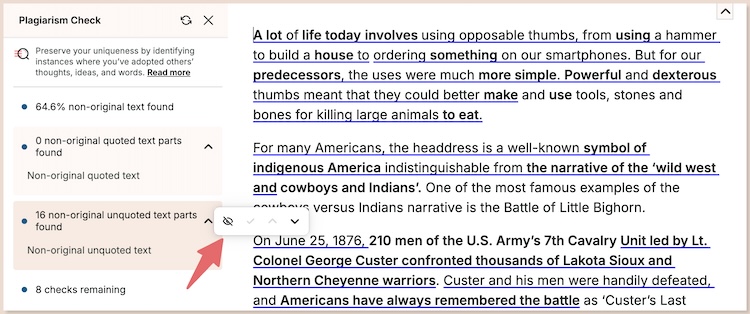Every writer knows plagiarism is bad. We must all express ourselves uniquely without stealing thoughts, words, and ideas from others. But sometimes it’s hard to be original and unintentional plagiarism creeps into our work. Especially when on a tight deadline, you may let another’s words slip into your content without proper attribution.
How to Use ProWritingAid's Plagiarism Checker
The Plagiarism Check feature is an add-on to the premium package, but well worth the money spent. You can include plagiarism checks in your ProWritingAid license by buying checks in bundles of 10, 100, 500 and 1000 to suit your needs.
Each check will check a maximum of 2000 words of your text. Checking 500 words would use one check, and checking 10,000 words would use 5 checks. If you want to check the same 2000 words twice, you will need to use another check.

The Plagiarism Check is easy to use. Click on it like any other report, and it automatically generates results. If you can't see the Plagiarism icon, you may need to click on 'More Reports', as above.
Once you have run the report, you'll see a menu along the left side of your screen.

This will tell you:
- What percentage of your text is non-original
- How much of that non-original text is quoted
- How much is unquoted
You'll also be able to see how many plagiarism checks you have left to use.
You'll see two types of colored highlights in your text, corresponding to the categories in the menu. Blue highlights indicate unoriginal text that you have quoted. You can use these highlights to check that you've cited the highlighted quotation. While ProWritingAid can't check your citations for you, it will highlight where you may not have cited text correctly. Purple highlights in your text indicate unoriginal that hasn't been quoted. Check through these highlights to find links to the original sources which you can use in your citations.
If you want to work methodically through each highlight, hover over the category you want to focus on in the menu.

Use the arrows on the navigation toolbar to move through the highlights in your document. Each highlight will show you where the highlighted text has come from so that you can check your sources and citations.
Once you have made sure that you haven't plagiarised, you can use the eye icon to hide the highlights for one category so you can focus on the other.
So, now you know how the check works, let's dive a little deeper into what counts as plagiarism and how you can avoid it.
Why Is Plagiarism Bad?
Foremost, you’re committing fraud when you pass someone else’s work as your own. And as a writer, we should all realize how important original work is to each of us. Just as you wouldn’t want someone to take credit for something you wrote, you shouldn’t try to pass off others’ content as your own.
We work hard to create. When someone steals our hard work, we lose credit for that originality. And that’s a hard egg to swallow. Not only is it unethical, but it’s incredibly disrespectful to take credit for what doesn’t belong to you.
Plagiariam can irrevocably damage your reputation as a writer. Why risk your livelihood by taking something that doesn’t belong to you or not sourcing your work appropriately? Once you’ve lost your reputation as trustworthy and your integrity as a writer, clients won’t hire you and readers won’t buy your books anymore.
Plagiarism.org reports that in the United States:
- "Plagiarism can also be considered a felony under certain state and federal laws. For example, if a plagiarist copies and earns more than $2,500 from copyrighted material, he or she may face up to $250,000 in fines and up to ten years in jail."
Intentional Plagiarism
When you use someone else’s work word-for-word, such as copying and pasting content from a website into your own blog, you’re committing plagiarism intentionally. You are actively stealing someone else’s work.
And when you replace a few unique words in a sentence but keep the essence the same, you’ve plagiarized. And when you do this from multiple sources and mashed everything together, you’re still plagiarizing.
You can even plagiarize yourself when you recycle content for various other venues. You need to make each piece unique and original, or give the source and details to make it clear you have previously published this work elsewhere.
Unintentional Plagiarism
You don’t mean to but sometimes plagiarism slips through the cracks. You may copy and paste something from someone else’s work and perfectly cite your source, but end the quotation marks too early.
Some writers accidentally include the wrong citations in their work, especially if they’re using multiple sources to create an article. And others include more cited material than original thought in their content.
Another problematic area is when your paraphrasing is too close to the original wording.
Put simply, if you don’t include copied material in quotes—and cite it properly—you’re plagiarizing.
Preventing Plagiarism
There are two methods that will help prevent you from plagiarizing others’ work:
1. Education
The more you know about what makes up plagiarism, the better prepared you are to avoid it. Even if you have a college degree, you might not be aware you are unintentionally plagiarizing.
It is your responsibility to learn more about plagiarism and how to spot it. You shouldn’t leave it up to your editors or publishers. It all starts with your integrity as an author. Respect other writers’ work and hopefully they’ll respect yours.
2. Technology
Rely on technology like ProWritingAid to help you identify plagiarism before you send your work out there. If you're writing essays or submitting your work to journals and other publications, chances are your writing will go through a plagiarism checker anyway. ProWritingAid checks your work against thousands of other websites, databases, and online published works, so you can be sure you won't get caught out.

What to Do if You’ve Been Plagiarized
First, don’t run your work through "free" plagiarism checks. Per plagiarism.org, "This includes not running your writing through an untrusted plagiarism detection service as some of those actually funnel scanned essays into essay mill websites for the express purpose of letting others plagiarize them."
Next, you know how experts always encourage you to tell a story, especially when writing content for the internet? The more you personalize your work with your own stories, the harder it will be to plagiarize and the easier it will be to find your work when/if plagiarized.
All you need do it select a unique portion of your content (preferably one that includes a personal story) and Google it in quotes. Google will return any website that lists your content word-for-word.
When you do find your work has been plagiarized, here’s what plagiarism.org says you should do:
"How you respond will depend heavily on how the work was used. If it was used in a classroom or a professional publication, you’ll likely want to reach out to either the instructor or the editor and let them know about your findings.
"If the work appears elsewhere online, the stopping internet plagiarism guide at Plagiarism Today can help you either contact the plagiarist directly or reach out to their host to get the offending work removed.
"Beyond that, any further action would require consultation with a lawyer to see what additional legal remedies might be available."
Final Thoughts
Avoid duplicate content at all costs and keep your writing reputation squeaky clean. It’s much better you capture unintentional plagiarism with technology than to send it to a client, editor, or publisher and have them catch it.


